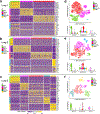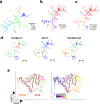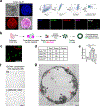Progenitor identification and SARS-CoV-2 infection in human distal lung organoids
- PMID: 33238290
- PMCID: PMC8003326
- DOI: 10.1038/s41586-020-3014-1
Progenitor identification and SARS-CoV-2 infection in human distal lung organoids
Abstract
The distal lung contains terminal bronchioles and alveoli that facilitate gas exchange. Three-dimensional in vitro human distal lung culture systems would strongly facilitate the investigation of pathologies such as interstitial lung disease, cancer and coronavirus disease 2019 (COVID-19) pneumonia caused by severe acute respiratory syndrome coronavirus 2 (SARS-CoV-2). Here we describe the development of a long-term feeder-free, chemically defined culture system for distal lung progenitors as organoids derived from single adult human alveolar epithelial type II (AT2) or KRT5+ basal cells. AT2 organoids were able to differentiate into AT1 cells, and basal cell organoids developed lumens lined with differentiated club and ciliated cells. Single-cell analysis of KRT5+ cells in basal organoids revealed a distinct population of ITGA6+ITGB4+ mitotic cells, whose offspring further segregated into a TNFRSF12Ahi subfraction that comprised about ten per cent of KRT5+ basal cells. This subpopulation formed clusters within terminal bronchioles and exhibited enriched clonogenic organoid growth activity. We created distal lung organoids with apical-out polarity to present ACE2 on the exposed external surface, facilitating infection of AT2 and basal cultures with SARS-CoV-2 and identifying club cells as a target population. This long-term, feeder-free culture of human distal lung organoids, coupled with single-cell analysis, identifies functional heterogeneity among basal cells and establishes a facile in vitro organoid model of human distal lung infections, including COVID-19-associated pneumonia.
Conflict of interest statement
Figures














Update of
-
Progenitor identification and SARS-CoV-2 infection in long-term human distal lung organoid cultures.bioRxiv [Preprint]. 2020 Jul 27:2020.07.27.212076. doi: 10.1101/2020.07.27.212076. bioRxiv. 2020. Update in: Nature. 2020 Dec;588(7839):670-675. doi: 10.1038/s41586-020-3014-1. PMID: 32743583 Free PMC article. Updated. Preprint.
References
Publication types
MeSH terms
Substances
Grants and funding
- T32 GM007365/GM/NIGMS NIH HHS/United States
- R01 AI157155/AI/NIAID NIH HHS/United States
- DK11572802/NH/NIH HHS/United States
- U24 DK085532/DK/NIDDK NIH HHS/United States
- U01 DE025188/DE/NIDCR NIH HHS/United States
- UH3 CA255135/CA/NCI NIH HHS/United States
- U01 DK085532/DK/NIDDK NIH HHS/United States
- UG3 HL145623/HL/NHLBI NIH HHS/United States
- T32 AI007502-23/NH/NIH HHS/United States
- WT_/Wellcome Trust/United Kingdom
- T32 AI007502/AI/NIAID NIH HHS/United States
- R01 HL142549/HL/NHLBI NIH HHS/United States
- T32 GM007365-44/NH/NIH HHS/United States
- U01 CA176299/CA/NCI NIH HHS/United States
- R56 AI111460/AI/NIAID NIH HHS/United States
- 5R01HL14254902/NH/NIH HHS/United States
- HHMI/Howard Hughes Medical Institute/United States
- U19 AI057229/AI/NIAID NIH HHS/United States
- K08 DE027730/DE/NIDCR NIH HHS/United States
- U01 DK085527/DK/NIDDK NIH HHS/United States
- U01 CA217851/CA/NCI NIH HHS/United States
- U19 AI116484/AI/NIAID NIH HHS/United States
LinkOut - more resources
Full Text Sources
Other Literature Sources
Medical
Molecular Biology Databases
Research Materials
Miscellaneous

